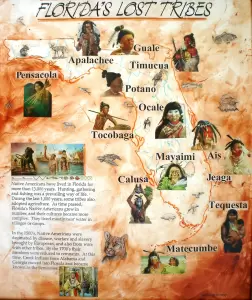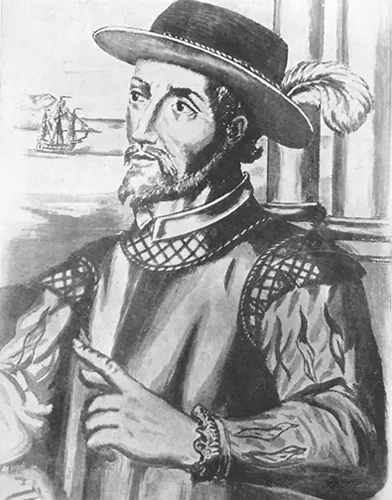



About 12,000 years ago, when the last Ice Age ended, the first people moved onto the land now known as Florida. From then until about AD 1500 is called “prehistory,” before Europeans made contact with Florida’s natives and began recording their history. Archaeologists divide this prehistory into three cultural periods:
Paleo-Indian Period
10000 to 7500 BC
The earliest people lived in a dry climate, when Florida’s land surface was twice as big as it is today. As the sea level rose, the coastline became submerged under the ocean. What is now coastline was then inland.
Archaic Period
7500 to 500 BC
The climate began to change, and by 3000 BC, the environment resembled modern conditions, with cypress swamps and hardwood forests. People adapted to increasingly productive coastal environments and were less nomadic, resulting in regionalized cultures.
Glades Period
500 BC to AD 1500
Advancements in technology were made, which allowed later identification of cultures and Glades periods I, II, and III by the types of pottery and tools they created and used.
When archaeologists first looked at southern Florida in the 1930s, they called it all the “Glades Area,” and its prehistoric people from all of the above periods “Paleo-Indians” (paleo = old). John Goggin, Robert S. Carr and John G. Beriault, James B. Griffin, and other archaeologists used more specific names for geographic areas and their related cultures until smaller tribes became evident: Caloosahatchee for the Calusa in southwest Florida, the Lake Okeechobee Basin with its Belle Glade culture in the center, and the Glades Area and culture in the south and up the east coast to Fort Pierce.
When the Spanish arrived, about 20,000 of these people lived in south Florida. By 1763, when the English gained control of Florida, most of the native population had died from warfare, enslavement, or European diseases. The several hundred who remained are said to have migrated to Cuba with the Spanish.
Juan Ponce de León
The Seminoles clashed with American settlers over land and escaped slaves who found refuge among the Seminoles. The government wanted the slave to move to the Indian Territory west of the Mississippi. Between 1818 and 1858, three wars were fought between Seminoles and the United States government. The descendants of the Seminoles and Miccosukees who refused to surrender or leave are now part of Florida’s modern economy.



